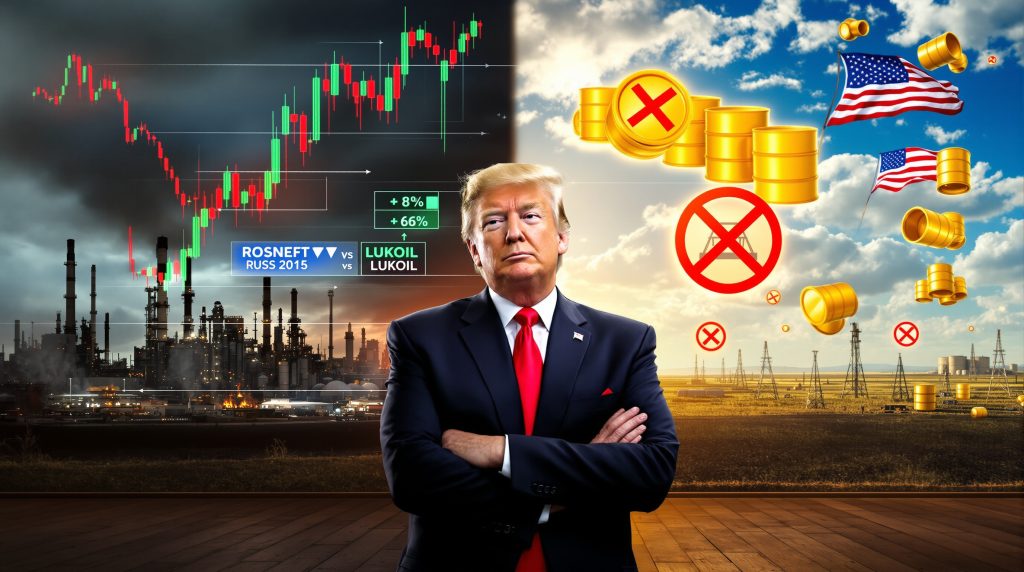Understanding the Current Sanctions Framework
The Trump administration's comprehensive approach to Russian energy sanctions represents a fundamental shift in economic warfare strategy. Following the October 22, 2025 announcement, the U.S. Treasury Department designated Russia's petroleum giants Rosneft and Lukoil under blocking sanctions, effective November 21, 2025. This strategic move targets companies collectively responsible for approximately 7.3 million barrels per day of production capacity, creating immediate disruption across global energy markets.
According to reporting from Oilprice.com, oil price movements surged 8% within 48 hours of the announcement, with WTI crude climbing above $60 per barrel and Brent exceeding $65. The market response reflected traders' immediate recognition that these measures could potentially disrupt over 3 million barrels per day of export flows from Russia's two largest petroleum companies.
Primary Designation Components
The sanctions framework encompasses several critical elements designed to isolate these companies from international financial systems:
• Complete asset freezes for both entities within U.S. jurisdiction
• Prohibition on all transactions involving U.S. persons or entities
• Blocking access to the U.S. financial system and dollar-denominated transactions
• Enhanced due diligence requirements for global petroleum traders
Secondary Sanctions Risk Assessment: Unlike previous Iran sanctions that employed strict liability provisions, the Treasury Department's language regarding secondary sanctions uses more permissive terminology. The announcement states that violations "may result in the imposition of civil or criminal penalties," representing a risk-based assessment approach rather than automatic enforcement.
Comparative Analysis with Historical Energy Sanctions
The 2025 Trump sanctions on Russian oil companies differ significantly from previous energy-focused economic measures in both scope and enforcement mechanisms. This represents the first time the United States has simultaneously targeted two major petroleum companies from the same country, creating unprecedented complexity for global supply chain management.
Historical Sanctions Comparison
| Sanction Target | Iran (2012-2015) | Venezuela (2019-Present) | Russia (2025) |
|---|---|---|---|
| Scope | National Iranian Oil Company | PDVSA (State enterprise) | Rosneft & Lukoil (Commercial entities) |
| Supply Impact | 1.5M bpd documented disruption | 800K bpd reduction | 3M+ bpd potential disruption |
| Enforcement | Strict liability for violations | Selective application | Risk-based assessment |
| Duration | 3-year implementation | Ongoing since 2019 | Implementation pending |
Iran Sanctions Precedent: The 2012-2015 Iranian sanctions demonstrated the effectiveness of coordinated international pressure. According to the U.S. Energy Information Administration, Iranian crude exports declined from approximately 2.5 million barrels per day pre-sanctions to under 1 million bpd by 2013, representing a 60% reduction in export capacity.
Venezuela Enforcement Model: PDVSA sanctions since 2019 have shown selective enforcement patterns, with some entities receiving waivers while others faced immediate designation. This approach resulted in Venezuelan production falling from 3.2 million bpd in 2012 to under 800,000 bpd by 2019, though multiple factors beyond sanctions contributed to this decline.
Strategic Timing and Geopolitical Context
The October 2025 timing of these sanctions reflects calculated diplomatic strategy aimed at maximising negotiating leverage while maintaining flexibility for future diplomatic engagement. Furthermore, market analysts have noted that the November 21 implementation date creates a clear window for potential negotiations or policy reversals.
Expert Analysis of Strategic Motivations
Ole Hansen, Head of Commodity Strategy at Saxo Bank, characterised the market dynamics following the announcement: "The sanctions disrupted flows that had quietly sustained Russian output despite broader Western embargos, transforming trader focus from oversupply concerns to supply-squeeze anxiety."
Diplomatic Leverage Theory: Industry observers suggest the sanctions serve multiple strategic purposes beyond immediate economic pressure. The measures demonstrate resolve to European allies concerned about energy security while creating tangible bargaining chips for potential peace negotiations regarding the Ukraine conflict.
Revenue Disruption Mathematics: Energy revenues historically comprise 30-40% of Russian government revenues, making petroleum export disruption particularly effective for reducing military funding capabilities. The targeted companies represent critical revenue streams that directly impact state fiscal capacity.
Targeted Companies and Production Impact
The sanctions specifically target Russia's two largest petroleum companies, each representing distinct aspects of the country's energy infrastructure and global market presence. However, understanding the potential tariffs impact on markets remains crucial for assessing broader economic implications.
Rosneft: Russia's State Energy Champion
Production Specifications:
- Production capacity: Approximately 5.2 million barrels per day
- Global market share: 6% of worldwide crude production
- Refining network: 13 major facilities across Russia and international locations
- International operations: Active in Venezuela, Iraq, Egypt, and Cuba
Critical Subsidiary Network:
- Rosneft Trading SA (Switzerland) – Primary international trading arm
- TNK-BP Holding (Cyprus) – Strategic asset management
- Rosneft Deutschland GmbH (Germany) – European downstream operations
Lukoil: Private Sector Integration
Operational Profile:
- Production capacity: 2.1 million barrels per day
- International presence: Operations across 30+ countries
- Downstream assets: 3,000+ retail stations throughout Europe
- Petrochemical integration: Major refined products producer
Strategic International Assets:
- ISAB refinery complex (Italy): 320,000 bpd processing capacity
- Petrotel-Lukoil refinery (Romania): 68,000 bpd capacity
- Multiple exploration projects across West Africa and Central Asia
Vertical Integration Complexity: Both companies operate comprehensive value chains spanning upstream exploration and production, midstream transportation and trading, and downstream refining and retail operations. This integration means sanctions affect multiple revenue streams simultaneously, amplifying economic impact beyond simple production disruption.
Immediate Market Response and Price Dynamics
The petroleum markets experienced their most volatile trading week since the initial Ukraine invasion, with price movements reflecting rapid shifts in trader sentiment and supply security concerns. In addition, the trump tariffs global impact continues to influence broader market sentiment across commodities.
Documented Price Movements
Week of October 21-25, 2025:
- Monday-Tuesday: Gradual decline on oversupply concerns (-2.3%)
- Wednesday (October 22): Sanctions announcement triggers 8% surge
- Thursday-Friday: Profit-taking and scepticism moderate gains
- Net weekly performance: +4.2%
Forward Curve Implications:
- 12-month futures contracts showed $3-5 premiums over spot prices
- Volatility indices reached highest levels since March 2022
- Options markets priced 15-20% probability of sustained $75+ oil prices
Short-Covering Rally Dynamics: Ole Hansen from Saxo Bank noted that what began as traders questioning oversupply narratives transformed into a short-covering rally following the sanctions announcement. The geopolitical risk premium replaced fundamental supply-demand considerations as the primary price driver.
Global Importer Strategic Responses
Major petroleum-consuming nations have implemented rapid supply chain adjustments, with each pursuing distinct strategies based on geopolitical positioning and energy security priorities. Consequently, many are reassessing the broader implications of US-China trade impact on their energy procurement strategies.
India's Procurement Challenge
Indian refiners face significant operational disruption, having increased Russian crude purchases to 1.8 million barrels per day, representing 35% of total crude imports according to Oilprice.com reporting. State-owned enterprises including Indian Oil Corporation and Bharat Petroleum are actively negotiating alternative supply agreements.
Immediate Response Actions:
- Emergency procurement missions to Middle Eastern suppliers
- Increased spot market purchases from West African producers
- Negotiations for term contracts with U.S. shale oil companies
- Strategic petroleum reserve drawdown considerations
Economic Impact Projections:
- Estimated $2-4 billion annual increase in import costs
- Potential retail fuel price increases of 3-5%
- Supply chain diversification investments required
China's Calculated Positioning
Chinese state-owned petroleum companies initially suspended new purchases while legal teams assessed sanctions compliance risks. Industry sources suggest Beijing may challenge the measures through continued transactions via non-dollar currencies and alternative financial channels.
Strategic Considerations:
- Existing long-term contracts worth $15+ billion annually
- Alternative payment mechanisms through yuan-denominated systems
- Potential coordination with other sanctioned energy suppliers
- Assessment of secondary sanctions enforcement likelihood
According to Reuters reporting cited in the Oilprice.com article, major Chinese companies including PetroChina, CNOOC, and Zhenhua Oil have temporarily halted purchases to evaluate sanctions implications.
Long-Term Energy Architecture Implications
These Trump sanctions on Russian oil companies represent a fundamental shift in global energy architecture, potentially accelerating trends toward regional supply chains and alternative payment systems that bypass traditional Western financial infrastructure.
Structural Market Transformation
Supply Chain Regionalisation Trends:
- Increased intra-Asian petroleum trade flows
- Enhanced Middle Eastern market share in traditional Russian export destinations
- Accelerated development of alternative pipeline infrastructure
- Strategic petroleum reserve buildup in key consuming nations
Financial System Fragmentation:
- Growth in non-dollar energy transactions
- Expansion of bilateral currency swap agreements
- Development of sanctions-resistant payment mechanisms
- Reduced reliance on SWIFT international transfer system
Market Psychology and Trading Patterns
The sanctions have fundamentally altered market psychology, shifting focus from traditional supply-demand fundamentals to geopolitical risk assessment. Traders now incorporate sanctions probability and enforcement likelihood into pricing models, creating new volatility patterns.
Volatility Index Evolution: The comparison to March 2022 levels (Russia's Ukraine invasion date) suggests markets perceive this as similarly disruptive to global energy flows. Options markets pricing 15-20% probability of sustained $75+ oil indicates significant uncertainty about long-term impact.
Sanctions Durability and Enforcement Scepticism
Market analysts express considerable scepticism about long-term sustainability of these measures, citing historical patterns in Trump administration sanction policies and practical enforcement challenges. For instance, examining oil price crash insights reveals similar market uncertainty patterns.
Expert Assessment of Implementation Likelihood
Bjarne Schieldrop, chief commodities analyst at SEB Bank, characterised Trump's sanctions approach as "predictably unpredictable," recommending traders sell the rally based on historical precedent. His analysis suggests previous Trump threats have evaporated after diplomatic engagement, making sustained enforcement unlikely.
Factors Supporting Continuation:
- Bipartisan Congressional support for Russia pressure
- European coordination on energy sanctions
- Demonstrated market impact validating effectiveness
- Domestic political pressure for stronger action
Factors Suggesting Potential Reversal:
- Trump's stated preference for negotiated solutions
- U.S. consumer concerns about petrol price impacts
- Potential Russian concessions in Ukraine negotiations
- Historical pattern of sanctions as negotiating tools
Secondary Sanctions Language Analysis
The Treasury Department's use of permissive language regarding secondary sanctions creates enforcement ambiguity. Unlike Iran sanctions that employed mandatory penalty provisions, the Russian measures state violations "may result in" penalties, suggesting discretionary application.
Compliance Risk Assessment: Financial institutions face uncertainty about enforcement likelihood, creating potential for selective compliance and evasion opportunities. This ambiguity may undermine sanctions effectiveness compared to stricter historical frameworks.
Circumvention Strategies and Evasion Mechanisms
Historical precedent from Iran and Venezuela sanctions suggests sophisticated evasion networks develop rapidly when major petroleum exporters face international restrictions.
Potential Bypass Methods
Shadow Fleet Expansion Tactics:
- Increased use of ageing tankers with obscured ownership structures
- Ship-to-ship transfers in international waters to avoid port restrictions
- False documentation and cargo mislabelling for destination concealment
- Flag-of-convenience registrations in non-aligned jurisdictions
Financial Engineering Solutions:
- Third-party trading companies as transaction intermediaries
- Barter arrangements avoiding traditional banking systems
- Cryptocurrency and alternative digital payment systems
- Bilateral currency agreements bypassing dollar denominations
Geographic Arbitrage Opportunities:
- Increased sales to non-aligned nations without sanctions enforcement
- Processing through friendly refineries for re-export with origin concealment
- Development of overland pipeline alternatives to maritime transport
- Strategic coordination with other sanctioned petroleum exporters
Market Friction vs. Supply Reduction
SEB Bank's analysis suggests sanctions may increase market friction through shadow fleet requirements and ship-to-ship transfers rather than materially reducing Russian crude supply. This assessment indicates potential price volatility without corresponding supply disruption.
Oil Price Scenarios and Market Projections
Price forecasting remains highly uncertain given multiple variables affecting sanctions effectiveness, Russian evasion capabilities, and broader geopolitical developments.
Scenario Analysis Framework
| Implementation Scenario | Probability Assessment | WTI Price Range | Duration Estimate |
|---|---|---|---|
| Full Compliance | 25% | $75-85 | 6-12 months |
| Partial Evasion | 45% | $65-75 | 3-6 months |
| Sanctions Reversal | 30% | $55-65 | 1-3 months |
Barclays Price Assessment: While acknowledging severe supply disruption could push Brent crude above $85 per barrel, Barclays analysts noted market participants remain sceptical about large, sustained disruption in Russian oil exports.
Volatility Premium Integration: Current pricing reflects geopolitical risk premiums rather than fundamental supply-demand imbalances. Forward curve premiums of $3-5 over spot prices indicate sustained uncertainty rather than structural tightness.
Trading Strategy Implications
Short-Term Positioning: The immediate price rally primarily reflects short-covering rather than fundamental bullish repositioning. Traders who had established short positions due to oversupply concerns were forced to cover following the sanctions announcement.
Long-Term Investment Considerations:
- Increased strategic petroleum reserve investments by consuming nations
- Accelerated renewable energy infrastructure development
- Enhanced energy security planning across major economies
- Regional supply chain diversification investments
What Does This Mean for Energy Security?
Trump sanctions on Russian oil companies are fundamentally reshaping global energy security calculations. Major consuming nations are accelerating supply diversification strategies while reassessing their exposure to geopolitical supply disruption risks.
Energy ministers across Europe and Asia have initiated emergency planning sessions to evaluate alternative supply sources. This mirrors concerns about broader trade disruptions, as governments simultaneously navigate complex international economic relationships.
The strategic petroleum reserve systems worldwide are being reassessed for adequacy. Countries previously comfortable with 30-90 day reserves are now considering 120-180 day capacity expansions to buffer against extended supply disruptions.
Navigating Energy Market Uncertainty
The Trump sanctions on Russian oil companies represent a pivotal moment in global energy geopolitics, creating immediate market disruptions while raising fundamental questions about future petroleum trade structures. Success will depend on sustained international cooperation, effective enforcement mechanisms, and Russia's willingness to prioritise economic stability over geopolitical objectives.
Market participants must navigate unprecedented uncertainty regarding sanctions durability, enforcement effectiveness, and circumvention development. The November 21 implementation deadline creates a critical decision point that could either validate the sanctions strategy or confirm sceptical assessments about their temporary nature.
Strategic Energy Security Implications: Regardless of ultimate sanctions effectiveness, these measures are accelerating global energy security investments beyond what climate policies alone might have achieved. Consuming nations are prioritising supply chain diversification, strategic reserve expansion, and alternative energy infrastructure development.
Investment and Trading Considerations: Energy markets will likely experience sustained volatility as traders assess real-time sanctions compliance, evasion network development, and diplomatic negotiation progress. This environment creates both risk and opportunity for sophisticated market participants capable of navigating geopolitical uncertainty.
Disclaimer: This analysis involves speculation about future geopolitical events and market developments that remain highly uncertain. Oil price forecasts and sanctions effectiveness assessments should not be considered investment advice. Market participants should conduct independent analysis and risk assessment before making trading or investment decisions.
Ready to Capitalise on Energy Market Volatility?
Discovery Alert's proprietary Discovery IQ model delivers real-time alerts on significant ASX mineral discoveries, including critical commodities like uranium and rare earth elements that become increasingly valuable during global energy transitions. With oil markets experiencing unprecedented volatility from sanctions and geopolitical tensions, savvy investors are positioning themselves in alternative energy sectors through Discovery Alert's discoveries page, which showcases historic examples of exceptional returns. Begin your 30-day free trial at Discovery Alert today to identify actionable opportunities ahead of the broader market.




